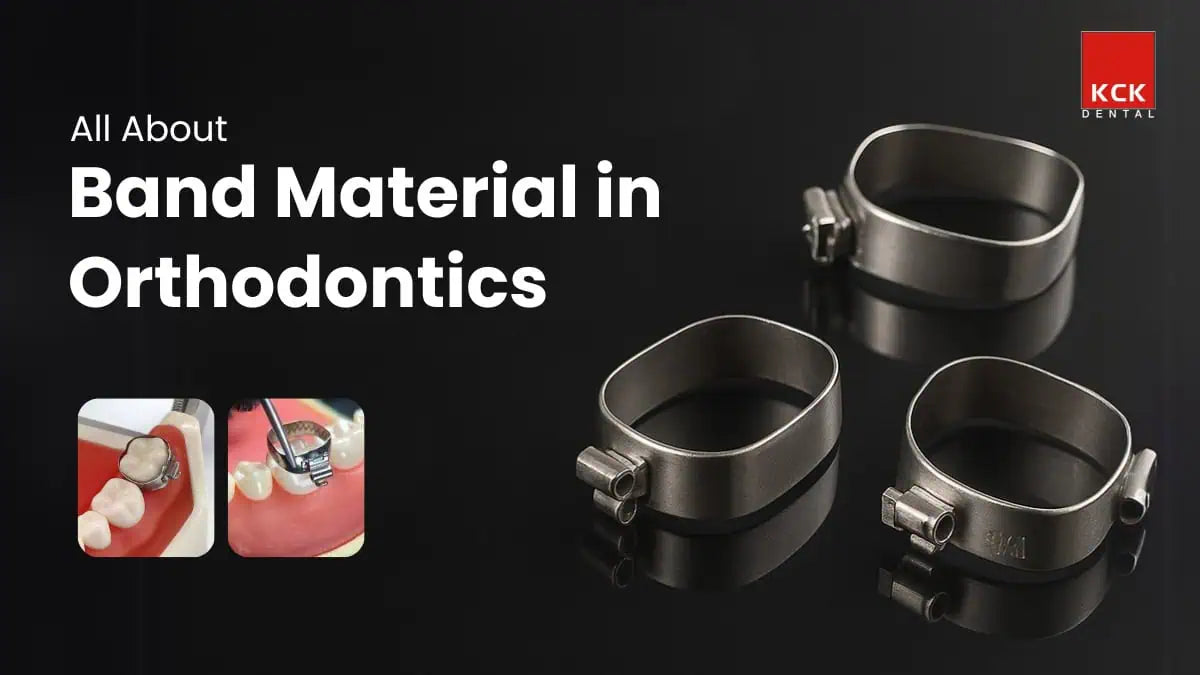Are you confused about choosing the band material for your patients? Have a close look at the band materials in orthodontics!
What is an Orthodontic Band?
Orthodontic bands are custom-fitted, ring-shaped devices designed to wrap around your patients’ teeth and be cemented in place. It’s a durable treatment than square brackets, by simply attaching to the front of a tooth. The orthodontic bands provide a solid anchoring system for the archwire of braces.

When Should You Use an Orthodontic Band?
Not all patients need an orthodontic band as part of their dental treatment.
You should use high-quality bands in orthodontics in the following circumstances;
- Major correction to tooth alignment, gaps, or bites
- If the bone structure is less malleable due to disease or age
- To isolate teeth in a child
- A Stable attachment point for headgear is used to correct an overbite
- If there is a history of dislodging or loosening traditional brackets
Band materials decide the quality of your banding procedure. It should be durable and provide a reliable connection point for orthodontic equipment.
Types of Orthodontic Band Materials
Here are the two styles your dentist is most likely to choose:
-
Stainless-Steel Bands
Stainless steel is still the first choice for almost every case. The metal is tough, springs back when bent, and resists the daily grind of chewing for years.
Why it's used:
- It shrugs off rust and keeps shining through mouth moisture.
- It shrinks under pressure from wires without cracking.
- It sits easily alongside metal fillings and crowns, so allergic reactions are rare.
Pros:
- Very durable
- Easy for dentists to adjust
- Works well with different types of braces
Cons:
- Might cause discomfort at first
- It can be visible when you smile
-
Glass-Ionomer-Based Bands
In some cases, the band is layered or glued with glass-ionomer cement, a softer, tooth-friendly material that seals small gaps and provides the enamel with extra protection. This option is typically reserved for very young patients or teeth that have begun to exhibit signs of sensitivity.
Why it's used:
- Slowly releases fluoride that helps keep cavities away.
- Forms a strong, lasting bond with the tooth.
- Feels gentler on enamel than some other options.
Pros:
- Cuts the chance of decay right at the band.
- Easier to handle for teeth that are already sensitive.
- A safe choice for kids or anyone with fragile enamel.
Cons:
- Not quite as tough as pure stainless steel.
- Might wear out a bit faster under heavy chewing.

Ideal Requirements of Band Material in Orthodontics
- Fits the contours of teeth closely
- Resist deformation under stress in the mouth
- Inherent springiness
- Have no occlusal interference
- Resist tarnish and corrosion
- Strong and stiff enough to maintain position
- Doesn’t extend subgingivally more than necessary
- Soft and ductile for shaping and comfort
Selection of Band Material in Orthodontics
- Incisor bands – These band materials are usually thinner and vary from 0.12 inch in width and 0.003 to 0.004 inch in thickness.
- Premolar bands – The premolar band material in orthodontics has a thickness of 0.04 inch and a 0.15-inch width.
-
Molar bands – Molar bands are commonly used in orthodontics with 0.005- 0.006 inch thickness and 0.18 to
0.20 inch width. -
Preformed bands – These bands are available in various sizes for different teeth with prewelded attachments.
Fabricating and Fitting Bands in Orthodontics
- Upper premolar bands – the bands are designed to be placed initially with hand pressure on mesial and distal surfaces by bringing the band close to the marginal ridges.
- Lower molar bands – these bands are initially seated with hand pressure on proximal surfaces and then, heavy biting force along buccal but not lingual margins.
- Upper premolar bands – these band materials in orthodontics are usually seated with alternate pressure on buccal and lingual surfaces.
- Lower premolar bands – these bands in orthodontics are designed for heavy pressure on the buccal surface.
Band Material in Orthodontics: Uses
- Enhances retention with welding or soldering
- Facilitates both lingual attachment and buccal attachment of auxiliaries
- It provides a broad surface and facilitates the attachment of multiple auxiliaries.
- Band material in orthodontics provides superior reliability due to better resistance.
- Easy to remove along with the attachment.

Difference Between Bonding and Banding in Orthodontics
Band or bond—what’s the difference?
Orthodontics applies different methods to align teeth and fix bite problems. The two procedures most used are bonding and banding.
Bonding deals with brackets being bonded to the facial surface of teeth using a special bonding agent. Relying on brackets, the archwire will be capable of being retained, which makes it possible for the teeth to be realigned sequentially.
Inserting band-shaped pieces of metal to wrap around the posterior teeth, referred to as molars, is classified as Banding. These bands function as conductors of orthodontic appliances and braces. Some brackets and tube brackets are cemented to the band, and they come pre-attached by a brace which makes their use more convenient.
Clinically, there’s no major difference in orthodontic management if the attachment slots are of the same dimensions and fit the tooth anatomy correctly.
However, the decision between bonding and banding depends on:
-
Attachment Options
Bands allow for multiple attachments in one cementation step. Bonding requires two separate steps for lingual and buccal attachments. -
Interproximal Space and Arch Length
Bands occupy more space, but this is recovered upon removal. Bonds save space during treatment. -
Tooth Protection
Bands protect the tooth better since they are securely cemented. Bonding may leave enamel exposed to scarring due to adhesive residue after removal. -
Ease of Placement and Removal
Bands are easier to remove and require minimal scaling. Bonding is suitable for mass application using the indirect technique.
The success of banding relies heavily on the quality and retention of the band material. A thorough understanding of orthodontic band materials and proper techniques ensures a well-contoured, long-lasting fit that stays secure in your patient’s mouth.
Looking for high-quality orthodontic bands? Check KCK Direct for the best, most reliable band materials for orthodontics in India.


